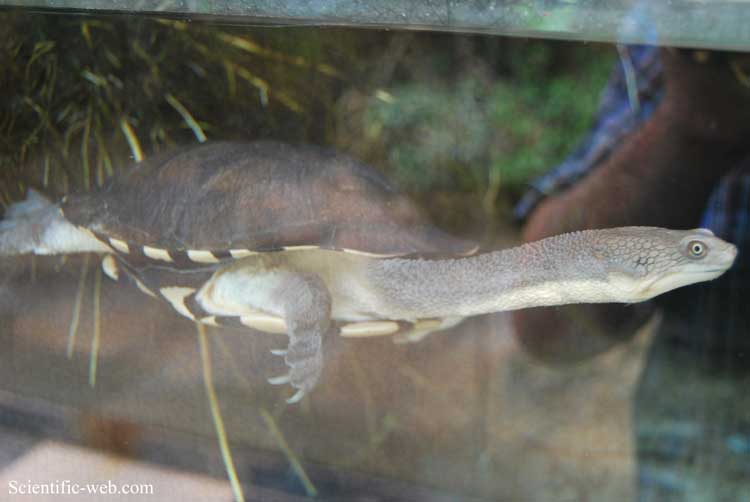
Chelodina longicollis, Photo: Michael Lahanas
Superregnum: Eukaryota
Regnum: Animalia
Subregnum: Eumetazoa
Cladus: Bilateria
Cladus: Nephrozoa
Superphylum: Deuterostomia
Phylum: Chordata
Cladus: Craniata
Subphylum: Vertebrata
Infraphylum: Gnathostomata
Superclassis: Tetrapoda
Cladus: Reptiliomorpha
Cladus: Amniota
Classis: Reptilia
Cladus: Eureptilia
Cladus: Romeriida
Subclassis: Diapsida
Cladus: Sauria
Cladus: Archelosauria
Division: Pan-Testudines
Division: Testudinata
Ordo: Testudines
Infraordo: Pan-Pleurodira
Subordo: Pleurodira
Superfamilia: Chelidoidea
Familia: Chelidae
Subfamilia: Chelodininae
Genus: Chelodina
Subgenus: Chelodina
Species: Chelodina longicollis
Name
Chelodina longicollis Shaw, 1794
Type locality: New Holland.
Lectotype: BMNH 1947.3.5.86
Synonyms
Testudo longicollis Shaw, 1794, holotype, not specified but presumed to be BMNH 1947.3.5.86
Chelodina novaehollandiae Duméril & Bibron, 1835, holotype, MNHN 6969, from Australia. Synonymy follows that of Boulenger (1889), Mertens and Wermuth (1955) and Wermuth and Mertens (1961).
Chelodina longicollis Fitzinger, 1826. First use of combination.
Chelodina sulcifera Gray, 1855, holotype, BMNH 1947.3.5.87, from Australia. Synonymy follows that of Goode (1967).
Chelodina sulcata Gray, 1856 [lapsus for Chelodina sulcifera Gray, 1855]. Synonymy follows that of Goode(1967).
References
Shaw, G., (1794). Zoology of New Holland. Vol 1. Davis, London. 33pp.
Georges, A. & Thomson, S. 2010. Diversity of Australasian freshwater turtles, with an annotated synonymy and keys to species. Zootaxa 2496: 1–37. Preview PDF Reference page.
Turtle Taxonomy Working Group (van Dijk, P.P., Iverson, J.B., Rhodin, A.G.J., Shaffer, H.B. & Bour, R.) 2014. Turtles of the world, 7th edition: annotated checklist of taxonomy, synonymy, distribution with maps, and conservation status. Chelonian Research Monographs 5(7):000.329–479 Reference page.
Vernacular names
čeština: Dlouhokrčka australská, želva hadí
English: Eastern long-necked turtle, Eastern Long-neck turtle
français: Tortue à long cou
magyar: Közönséges kígyónyakúteknős, kelet-ausztráliai kígyónyakúteknős
日本語: オーストラリアナガクビガメ
lietuvių: Australijos ilgakaklis vėžlys
Nederlands: Slangenhalsschildpad
polski: Żółw wężoszyi
ไทย: เต่าคองู
The eastern long-necked turtle (Chelodina longicollis)[6][7] is an east Australian species of snake-necked turtle that inhabits a wide variety of water bodies and is an opportunistic feeder.[7] It is a side-necked turtle (Pleurodira), meaning that it bends its head sideways into its shell rather than pulling it directly back.
Distribution
The species is found throughout south eastern Australia where it is found west of Adelaide (South Australia) eastwards throughout Victoria, Northern Territory and New South Wales, and northwards to the Fitzroy River of Queensland. Where these turtles come in contact with Chelodina canni they freely hybridise, exhibiting hybrid vigor in the Styx River Drainage of Queensland.[7][8]
Description
The carapace is generally black in color, though some may be brown. It is broad and flattened with a deep medial groove. The scutes are edged in black in those individuals with a lighter background color.[7] The plastron is also very broad and is cream to yellow in color with sutures edged in black.[7] The neck is long and narrow, typical of the subgenus Chelodina, and reaches a length of approximately 60% of the carapace length. The neck has numerous small pointed tubercles and is grey to black in color dorsally, cream below, as is the narrow head.[7] Females tend to grow to larger sizes and have deeper bodies. The maximum sizes recorded for females and males varies throughout the range, in river environments of the Murray it is 28.2 cm (11.1 in) and 24.9 cm (9.8 in) respectively, whereas in the Latrobe Valley it is 21.6 cm (8.5 in) and 18.8 cm (7.4 in) respectively.[7] It is thought this is linked to productivity of the local environment.[7]
When it feels threatened, this turtle will emit an offensive smelling fluid from its musk glands. This trait gives the turtle one of its other common names, "stinker".[9]
The eastern long-necked turtle is carnivorous, eating a variety of animals. This includes insects, worms, tadpoles, frogs, small fish, crustaceans, and molluscs.
Reproduction
In early summer, the female will lay between two and ten eggs in the banks of her aquatic habitat. Three to five months later the hatchlings break out of their shells. These young turtles often fall prey to predators such as fish and birds. Females will lay one to three clutches of eggs per year.
References
Turtle Taxonomy Working Group [van Dijk, P.P., Iverson, J.B., Rhodin, A.G.J., Shaffer, H.B., and Bour, R.]. 2014. "Turtles of the World, 7th edition: annotated checklist of taxonomy, synonymy, distribution with maps, and conservation status". In: Rhodin, A.G.J., Pritchard, P.C.H., van Dijk, P.P., Saumure, R.A., Buhlmann, K.A., Iverson, J.B., and Mittermeier, R.A. (Eds.). Conservation Biology of Freshwater Turtles and Tortoises: A Compilation Project of the IUCN/SSC Tortoise and Freshwater Turtle Specialist Group. Chelonian Research Monographs 5(7):000.329–479 doi:10.3854/crm.5.000.checklist.v7.2014
Shaw, G. (1794) Zoology of New Holland. Vol 1. Davis, London.
Duméril, André Marie Constant and Bibron, Gabriel (1835) Erpétologie Générale ou Histoire Naturelle Complète des Reptiles. Vol. 2. Paris: Roret.
Gray, John Edward. (1856). On some new species of freshwater tortoises from North America, Ceylon and Australia, in the collection of the British Museum. Proceedings of the Zoological Society of London 1855 (23):197–202. [Published Feb 1856].
Gray, John Edward. (1856). Catalogue of Shield Reptiles in the Collection of the British Museum. Part I. Testudinata (Tortoises). London: British Museum, [Published Mar 1856].
Kennett, R; Georges, A. (1990). "Habitat utilization and its relationship to growth and reproduction of the eastern long-necked turtle, Chelodina longicollis (Testudinata: Chelidae), from Australia". Herpetologica. 46 (1): 22–33. JSTOR 3892599.
Kennett, R., Roe, J., Hodges, K., and Georges, A. 2009. Chelodina longicollis (Shaw 1784) – eastern long-necked turtle, common long-necked turtle, common snake-necked turtle. In: Rhodin, A.G.J., Pritchard, P.C.H., van Dijk, P.P., Saumure, R.A., Buhlmann, K.A., Iverson, J.B., and Mittermeier, R.A. (Eds.). Conservation Biology of Freshwater Turtles and Tortoises: A Compilation Project of the IUCN/SSC Tortoise and Freshwater Turtle Specialist Group. Chelonian Research Monographs No. 5, pp. 031.1–031.8, doi:10.3854/crm.5.031.longicollis.v1.2009
McCord, William P.; Thomson, Scott A. (2002). "A new species of Chelodina (Testudines: Pleurodira: Chelidae) from northern Australia". Journal of Herpetology. 36 (2): 255–267. doi:10.1670/0022-1511(2002)036[0255:ansoct]2.0.co;2. JSTOR 1565998.
Eisner, T.; Jones, T.H.; Meinwald, J.; Legler, J.M. (1978). "Chemical composition of the odorous secretion of the Australian turtle, Chelodina longicollis". Copeia. 1978: 714–715. doi:10.2307/1443705.
Retrieved from "http://en.wikipedia.org/"
All text is available under the terms of the GNU Free Documentation License

